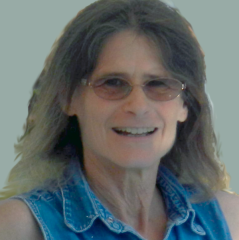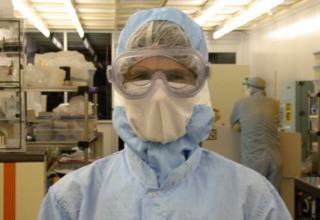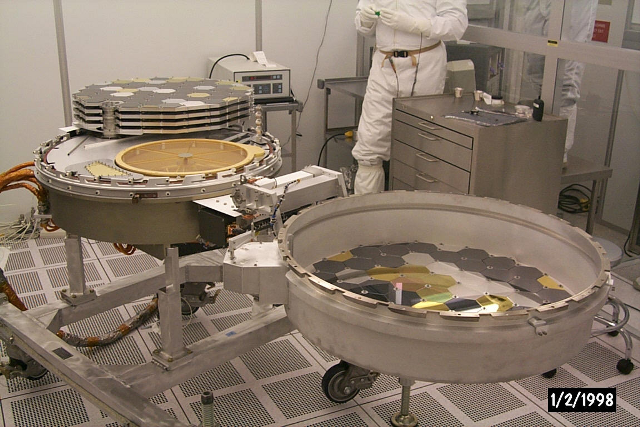Get to know Center researchers with this new periodic feature!
 Dr. Amy Jurewicz is an Assistant Research Professor in the ASU Center for Meteorite Studies (CMS) and School of Earth and Space Exploration. Her research in the Center is focused on the recovery, analysis, and interpretation of materials from the NASA Genesis mission, which collected solar wind samples for two years prior to a hard landing in Utah upon its return to Earth.
Dr. Amy Jurewicz is an Assistant Research Professor in the ASU Center for Meteorite Studies (CMS) and School of Earth and Space Exploration. Her research in the Center is focused on the recovery, analysis, and interpretation of materials from the NASA Genesis mission, which collected solar wind samples for two years prior to a hard landing in Utah upon its return to Earth.
Solar wind samples are a good surrogate for the solar nebula because a preponderance of scientific evidence suggests that the outer layer of the Sun preserves the composition of the early solar nebula.
For most rock-forming elements, the process of solar wind ejection from the Sun does, however, cause significant fractionation of some elements and isotopes. So, Genesis research requires collaboration with solar physicists and, in addition to finding a surrogate for the solar nebula, provides information on solar processes.
CMS: How were you first drawn to meteoritics, cosmochemistry, and NASA?
Jurewicz: My undergraduate degree was a BA in geology (Phi Beta Kappa) from Occidental College, but I took classes at Caltech, a nearby school, where I considered going as a grad student in paleontology under H. Lowenstam. I wasn’t accepted at Caltech for grad school because I managed to graduate Occidental without any chemistry. My graduate work was primarily at Rensselaer Polytechnic Institute (RPI; Troy, NY), first in structural geology (microstructure) with M. Brian Bayly, and I took classes with W. Means at SUNY Albany. I started chemistry by taking graduate-level physical chemistry. Then, after a short stint elsewhere, I returned to RPI and worked with E. Bruce Watson, doing high-temperature, controlled-atmosphere phase-equilibrium and diffusion experiments for my PhD.
It seemed like every kid of my generation wanted to be an astronaut and developed a fascination with NASA. For me, that seed started watching the Apollo 11 landing, but didn’t develop until after my PhD in high-temperature experimental petrology of earthly basalts and post-doctoral research at the US Air Force Research Laboratory focused on fiber-reinforced ceramic composites. At that point, my husband and I had moved to Houston and I had the choice of being a ceramic engineer for a start-up company vs. being a post-doctoral researcher in the experimental petrology labs at the Johnson Space Center (JSC). The engineering position paid 30% more, but the NASA job was located next to the astronaut’s gym and I got to play with synthetic molten basalts. It was a no-brainer for me to go to NASA.

CMS: Tell us more about your work on NASA missions.
Jurewicz: There were 3 main missions: Genesis (solar wind sample return), Stardust (comet sample return) and SCIM (Mars dust sample return).
Genesis – Still active and “project scientist”. Unlike most JPL project scientists, I did not work with the administration. Instead, I characterized, purchased and/or fabricated collector materials and interfaced between the Principal Investigator and JPL engineering on some of the projects, such as the collector foil experiment.

SCIM — The mission was proposed several times, but was closest to flying in 2003 when it lost on the second round to the Phoenix Lander, but I would start again in a NY minute. I sequentially filled multiple positions from the project's inception through its many iterations, including JPL’s SCIM Project Scientist, Co-Investigator (2003), and lead on the dust collector (DUCE). The most fun was arcjet testing aerogel at Ames to study the thermal stability of aerogel during the aeropass, and participating in the design, testing, and fabrication of the aerogel collector modules to ensure that the martian dust SCIM collected would be suitable for scientific study.
CMS: You’re very active in both your research and public outreach; tell us why you love what you do.
Jurewicz: I am simply fascinated by the workings of the natural world. It doesn’t matter if it is the way a defect moves through a crystal or how the Sun makes (and ejects) solar wind. I am addicted to looking at data and seeing trends that explain processes, especially how materials are made and subsequently change.
I love telling people about meteorites and what they mean as bits of returned sample. I love pallasites and metallic meteorites because I can tell the unsuspecting that they are snapshots into the interior of a solar system body that might have been trying to form a planet. Then I tell them that the Sun is 99% of the solar system, that we can use it as a “fossil” of the solar nebula, and then hand them a piece of the Allende meteorite and tell them that they are, in essence, holding a piece of the Sun. How can you have more fun than that?
Read more about Dr. Jurewicz’s research, here!
In 2011, Dr. Jurewicz was listed as one of the 51+ Women in Planetary Science – read her interview, here!
Jurewicz A. J. G., Rieck K. D., Hervig R., Burnett D. S., Wadhwa M., Olinger C. T., Wiens R. C., Laming J. M., Guan Y., Huss G. R., Reisenfeld D. B., and Williams P. (2020) Magnesium isotopes of the bulk solar wind from Genesis diamond-like carbon films. Meteoritics & Planetary Science 1-25. https://doi.org/10.1111/maps.13439
Burnett D. S., Jurewicz A. J. G., and Woolum D. S. (2019) The future of Genesis Science. Meteoritics & Planetary Science 54(5): 1092-1114.
Huss G. R., Koeman-Shields E., Jurewicz A. J. G., Burnett D. S., Nagashima K., Ogliore R., and Olinger C. T. (2019) Hydrogen fluence in Genesis collectors: Implications for acceleration of solar wind and for solar metallicity. Meteoritics & Planetary Science 1-26. https://doi.org/10.1111/maps.13420



